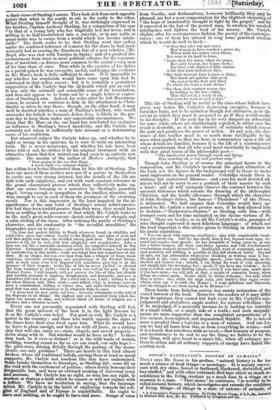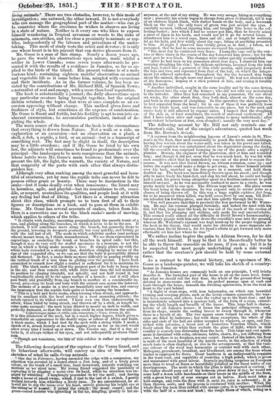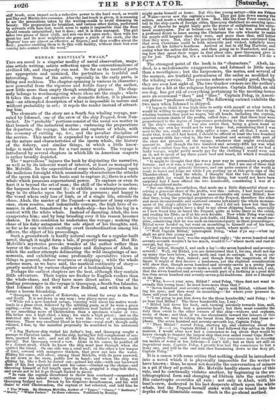008913'S NA VCR 9.LIST'S SOJOURN IN JA MAICA. * TRULY says
Mr. Gosse in his preface, "natural, history is far too much a science of dead things---e necrology. It is mainly conver- sant with dry skins, furred or feathered, blackened, shrivelled, and hay-stuffed," and with other externals that bear about as much re- semblance to the living creature as a mask does to a visage or a mummy to a. man. " That alone," he continues, "is worthy to be called natural history, which iweestigatesand reeerda the condition of living things--of things in a state of nitturtti–if animals, of by Richard Hill, Esq., 80. &c. A Naturalist's Sojourn kJ" leii‘PlpgAnpr swgr,y,.. Assist living =buds?! There are two obstacles, however, to this mode of investigation; one outward, the other inward. It is not everybody who can manage the geographioal_part of the matter—who can go to countries where the creatures he wishes to observe are living in a state of nature. Neither is it every one who likes to expose himself wandering in. Tropical savannas or woods to the risks of miasmata, sun-strokes, and too close a,proximity to animals or rep- tiles, independently of the labours and privations of the under- taking. This mode of study tests the artist and devotee ; it is only one whose heart is in his pursuit that can derive pleasure from it.
Mr. Gosse is a man of this stamp. Nearly a dozen years ago, he gave the world his observations upon nature, made whilst a settler in Lower Canada; some seven years afterwards he pre- sented it with the results of a residence in Jamaica, so far as ap- plied to the birds of the island. His present volume is of a more various kind ; containing eighteen months' observation on animal and vegetable life as it came before him, mingled with excursions and their incidents. As in the former volume, he has been as- sisted by the contributions of Mr. Richard Hill, of Spanish Town; a naturalist of zeal and energy, with a more than local reputation.
The book is substantially a journal; the daily observations upon any particular creature being brought together, but the original diction retained; the topics that were at once complete as an ex- cursion appearine. Without change. This method gives force and freshness of style, but sometimes at the expense of condensation. Mr. Gosse is fluent and fertile, but his fertility is apt to run into ex- uberant enumeration ; he accumulates particulars, instead of de- picting the whole.
The main source of' the freshness of the book is the circumstance that everything is drawn from Nature. Not a walk or a ride an exploration or an excursion—not an observation on a plat, a shell, a fish, a reptile, a bird, or an animal—but is a transcript of somethine. real. The fact may be slight in itself, the description may be :little overdone; and if Mr. Gosse be tried by his own law, the adjuncts will sometimes be found to predominate over the principal—the landscapes to be more conspicuous than the animals, whose habits were Mr. Gosse's main business : but there is ever present the life, the light, the warmth, the variety of Nature, and that congruity of the parts with each other that always distin- guishes her.
Although very often ranking among the most graceful and beau- tiful of creatures, yet by man the reptile tribe can never be felt to possess. either grace or beauty. There may be fascination in the snake—hut it looks deadly even when. innocuous ; the lizard may be harmless, agile, and playful—but its resemblance to eft, croco- dile, or serpent, neutralizes its qualities and people look at it with any feeling but that of liking. Yet there is a strange attraction about this class, which prompts us to turn first of all to their figures or descriptions in a book, and to gaze at them in exhibi- tions. Mr. Gosse has several accounts of snakes, taken from life. Here is a corrective one as to the black snake's mode of moving,
which applies to others of the tribe. -
"It climbs with facility, mounting perpendicularly the smooth trunk of a tree, and gliding .along the branches, on which it loves to lie in the sun. If alarmed, it will sometimes move along the branch, but generally drops to the ground, lowering its foreparts gradually but very. quickly, and letting go with the tail last of all. The mode in which colubrme snakes (and perhaps others) -mount trees, is, I think, misunderstood. We see them represented in engravings, as encircling the trunk or branches in spiral coils: but this, though it may do very well for stuffed specimen in a museum, is not the way in Which a living snake mounts a tree. It simply glides up with the whole body extended in a straight line, doubtless clinging by means of the tips ofthe expanded ribsi as we can see that the body is perceptibly dilated and flattened. In fact, a snake &edema-more difficulty in passing swiftly up the vertical trunk of a tree than in gliding over the ground. I have been astonished to remark how slight a contact is ° sufficient for it to maintain its hold: The bltiek snake will allow the greatest part of its body to hang down in the air, and thus remain still, while little more than the tail maintains its position by clinging (straight, not spirally, and not half round it, but longitudinally along it) to the upper surface of a branch : and it will often pass-freelyand gratefully from one branch to another at a considerable in- terval, projecting its head and body with the utmost ease across the interval. The motions of a stake; in a tie& are beautifully easy and free, and convey the impreesion that thereptile feels quite at home among the branches. "This 18 a held and fierce snake, often turning when struck, and approach- ing its assailant *ith the head' erected in a most menacing attitude; the mouth opened to its widest extent. I have seen one thus endeavouring to attack, when foiledby being struck, and thrown off by a stick, at length be- come 'quite enraged; the neck being dilated to nearly an inch in width, and perfectly flattened, so that the white-skin could be seen between the scales. Tolleatraque ininas et sibila coils Onuentera.!--V180. Georg. iii. 421. It is this dilatation of the neck, but in a much higher degree, which gives so remarkable an appearance to the deadly najas or cobras of Africa and India. A blacksnake which I, had tied .by the neck with a string while I made a sketch.of it, struck fiercely at me with gaping jaws . as far as its cord would allow, every time I looked up or down. The fereolee say, that if a dog at- tacks it, it always strikes at his eyes, and not infrequently produces blind- ness.
"Though not venomous, the bite of this coluber is rather an unpleasant affair."
The following description of the capture of the 'Venus lizard, and its Mamba .'afterwatie, will- convey an idea 'Of - the author's sketches Of whathie .calls living_ animals. ; [ ' One day. in Pebrnary,-having aeeended-the ridge With a companion, my attention WAS, 4r,rested by a-lizard about- a- foot keg, and of a lively green colour, on the-trunk of a small tree, head downward, intently watching:our motions -rfuHve"iftdod near. My young: friend suggested the'Pobalifility of ea_ptining-ithy kipping a noose over its head, while Its attenden. was en- gaged by :whistling. I laughingly proceeded: to try the-spoil; and "laving reagefanoese4 Wyman twine,;ewb.,- I tied to the end of- a switch, Isently l'115.ekirtf'lviar41--Illingiehistling. • e/ly-tene. To My_estonishment, be al-
io Me to dip the noose over head,• merely glancing his bright eye at
-theirstring."..ssli*W:', .4 ei -t• music ceased; s green-coated forestei"Wge ' '011a the
• • , 'greatly to his an-
nuance, at the end of my string. He was very savage, "biting at everything near ; presently his colour began to change from green to blackish, till it was of an uniform bluish black, with darker bands on the body, and a brewniah black on the tail ; the only. trace of green was just around the eyes. I carefully secured, without injuring him, and brought him home in the eel- tooting-basket ; into which I had no sooner put him, than he fiercely seized a piece of linen in his teeth, and would not let it go for several hours. I transferred him to a wired cage, linen and all ; and at length he suddenly let go his hold, and flew wildly about the cage, biting at anything presented to him. At night I observed him vividly green as at first ; a token, as I presumed, that he had in some measure recovered his equanimity.
"The next day he continued very fierce. I hung the cage out in the sum: two or three times in the course of the day I observed him green ; but for the most part he was black. The changes were rather quickly accomplished.
" After he had been in my possession about four days, I observed him one morning sloughing his skin ; the delicate epidermis, loosened from the body and legs, looked like a garment of thin white muslin, split irregularly down the legs and toes, and separated from that of the tail, on which the integu- ment yet adhered unbroken. Throughout the day the loosened skin hung about the animal, though more and more loosely. He had not abated a whit of his fierceness; leaping at a stick pointeil at him, and seizing it forcibly with his teeth.
" Another individual, caught in the same locality and by the same device, I introduced into the cage of the former ; who did not offer any molestation to the intruder. After they had remained in my possession, the one about six weeks, the other about four, they both died, almost on the same day, and both in the process of sloughing. In this operation the skin appears to be fust separated from the head ; for in one of these it was perfectly loose from the whole head, and was removable in one piece, but to the neck and entire body it still adhered by organic union. I suspect that the sloughia',g of the skin is, at least sometimes, the result of universal excitement. All that I have taken alive and caged, (amounting to many individuals,) after most violent behaviour at first, soon sloughed ; usually the very next day."
The following account by Mr. Hill not only reminds one of Waterton's ride, but of the ensign's adventures, quoted last week from Mr. Burton's Scinde.
"A cayman from the neighbouring lagoons of Lyson's estate in St. Tho- mas's in the East, that used occasionally to poach the ducks and ducklings, having free warren about the water-mill, was taken in his prowl and killed. All sorts of suspicion was entertained about the depredator among the ducks, till the crocodile was surprised lounging in one of the ponds after a night's plunder. Downie, the engineer of the plantation, shot at him and wounded him ; and though it did not seem that he was much hurt, he was hit with such sensitive effect that he immediately rose out of the pond to regain the morass. It was now that David Brown, an African wainman, came up ; and before the reptile could make a dodge to get away, he threw himself astride over his back, snatched up his fore-paws in a moment, and held them doubled up. The beast was immediately thrown upon his snout; and though able to move freely his hind-feet, and slap his tail about, he could not budge half a yard, his power being altogether spent in a fruitless endeavour to grub himself onward. As he was necessarily confined to move in a circle, he was pretty nearly held to one spot. The African kept his seat. His place across the beast being at the shoulders, he was exposed only to severe jerks as a chance of being thrown off. In this way a huge reptile eighteen ,foot longp for so he measured when killed, was held manutortiby one man, till Dow- nie reloaded his fowling-piece' and shot him quietly through the brain. "You will perceive that this is precisely the feat performed by Mr. Water- tan. He says his cayman plunged furiously, and lashed the sand with his tail, but that, being near the head, he was out of the reach of the strokes of it, and that his plunging and striking only made his seat uncomfortable. This seemed really almost all the difficulty in David Brown's horsemanship; but as every plunge with him wily drove the crocodile's nose into the ground, whereas 3fr. Waterton's cayman was kept head-up by the people tugging at the hook in his throat, that would make his chivalry a more desperate ad, venture than David Brown's, for his beast's efforts to get forward only more effectually set him fast where he was." "
We rather incline to give the palm to African Brown, for he dil all the work himself. It may be that it is theoretically better tO be able to throw the crocodile on his nose, if you can ; but it is to be suspected that most people undertaking such a ride woulil rather that the creature's jaw should be held by some external force.
As a contrast to the natural history, and a specimen of Mr.. Gosse as a landscape-painter, we will take his sketch of a country. house in Jamaica.
"As Jamaica houses are commonly built on one principle, I will briefly describe it. The furnished part of the house is all on the same level, form• lag what we should call the first floor' the whole of the ground-floor being devoted to store-rooms and cellars. An arched passage open at each end leads through the house, beneath the dwelling apartments, from the road in, front to the yard behind. "A flight of stone steps, with iron balustrades, on which run beautiful twining and creeping plants, such as the lovely crimson quannelit, the waxe like hoya camosa, and others, leads the visitor up to the front door; and he is immediately ushered into a spacious hall, of the form of a cross, extend-- Mg the whole length and breadth of the house. This large hall is charac- teristic of all Jamaica houses : it forms the principal sitting-room ; and,, from its shape, admits the cooling breeze to sweep through it, whenever there is a breath of air. The two square areas formed by one side of the cross are filled by bedrooms; but with these exceptions, the whole of the aides and ends of the hall are either occupied by windows, pr open, and fur- nished with jalousies, a broad sort of transverse Venetian blinds, which freely admit the air while they exclude the glare of light, which in this courifry is scarcely less distressing than the heat, This large and cool apart- ment is furnished with sofas, ottomans, tables, chairs, &e., not differing from ours; but there is no fireplace, nor any carpet. Instead of the latter, the flow is made of the most beautiful of the native woods, in the selection of which much taste is often displayed, as also iu the arrangement, 80 that the van- ens colours of the wood may harmonize or contrast well with each other. Mahogany, greenheart, breadinit., and bloodheark are among the trees whose timber is employed for floors. Great hardness is an indispensable requisite in the wood used, and capability of receiving a high polls which is given and maintained with great labour. Scarcely anything surprises an European more than to tread on floors as beautifullypolished as the finest tables of our drawingfoonis. The mode in which the gloss is daily renetVed is curious : if the visitor should peep out of his bedroom about dawn of day, he would see some half a dolma sable handmaids on their knee*, in the middle of Melee; with a great tray full of sour oranges cut in halves. Each =aid take!' half-orange, and rubs the floor with it .until its juice is exhausted; it f.e. then thrown, :aside,. and the processis continued with another. When the
whole floor has been Met ribbed with orange-juice,lt is fasly scrubbed
with the 'Ulf '6f a- e'60.441-Mitiliisk '; the rough fibres or elf, ebtingitets
stiff brush, soon impart such a reflective power to the hard wood, as would put Day and Martin into ecatacies. After the last touch is given, it is amusing to Bee the precautions taken by the waiting-maids to avoid dimming its beauty. The preparation for breakfast, and various other duties, performed by servants with ham feet, would seem to make it impossible that the floor should remain untarnished; but it does ; and it is thus managed. The girl takes two pieces of linen cloth, and sets one foot upon each ; then with her great-toe and its next neighbour she grasps a pinch of the cloth, (for the Negroes' toes are almost as effective as fingers,) and thus scuffles about the floor ; practice enabling them to do this with facility, without their feet ever coming into contact with the wood."




























 Previous page
Previous page